#Boy Scouts of America Museum
Text
Scouts Winter Camp-in ‘Night in the Museum’
January 28th, 2023 – Amogh and his dad headed out on an hour drive to ‘The Academy of Natural Sciences’, Philadelphia for their first ever Scouts Winter Camp-in.
Pack 17 had exclusive access to the museum facilities including overnight camping at the museum.
Themed as “Night in the Museum”, fun filled and adventurous itinerary included:
Welcome presentation in the auditorium by the museum…

View On WordPress
#Boy scouts of America#BSA#Kids#Night in the Museum#Northern NJ Council#Scouting#Scouts#Scouts life#The Academy of Natural Sciences#Winter camp in#Wolf scouts
0 notes
Note
is it true that they removed mentions of tintin journaling/actually mentioning his job/etc when they redrew some of the older tintin comics? i swear i remember seeing examples of that once but i have no clue where to find them again
I definitely know which post you're talking about, but I can't find it either. I'll try to compile what I remember and/or know about offhand...
For the most part, the most references to Tintin being a reporter come early on in what are considered the "newsprint editions" of the comics. The first nine albums were serialized in Le Petit Vingtieme and Le Soir Jeunesse, and these pages were later re-collected and coloured (and occasionally cut down/rewritten) for what are now known as the "Casterman editions".
Tintin being a reporter is all over Land of the Soviets, and it's introduced as early as page 1. It's the silliest album, but it's also the only album thoroughly revolving around Tintin going on a reporting assignment.
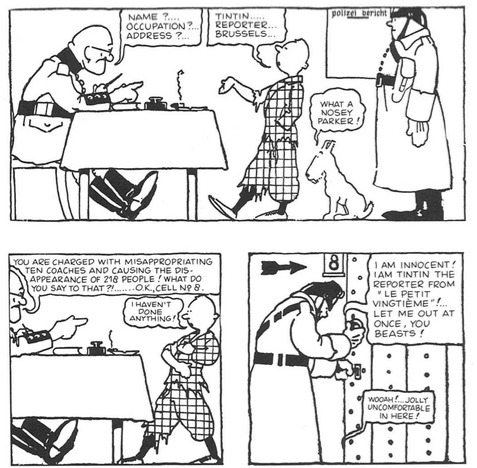
(Soviets pg. 4. By God, look at that guard in the upper right. He looks like the RESPECT! butler)
Tintin is still a reporter in Congo, but it's scaled far back in the redrawn Casterman edition. In the latter, it's kept to one mention in the very first panel, which was also turned into the first appearance of Dupont and Dupond:
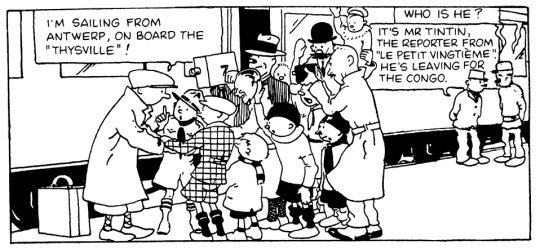
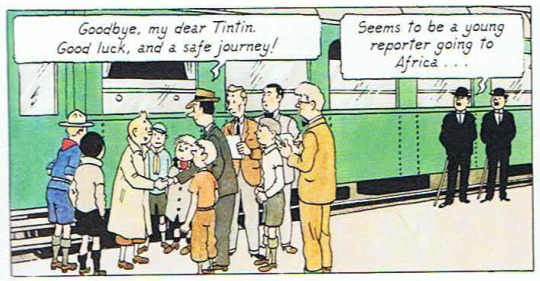
(Congo pgs. 1)
Meanwhile, the newsprint edition has a scene where newspaper agents try to scout Tintin as a reporter, I guess because his stories are just that good. He ultimately declines, claiming Petit Vingtieme is paying him way more than what they offer.
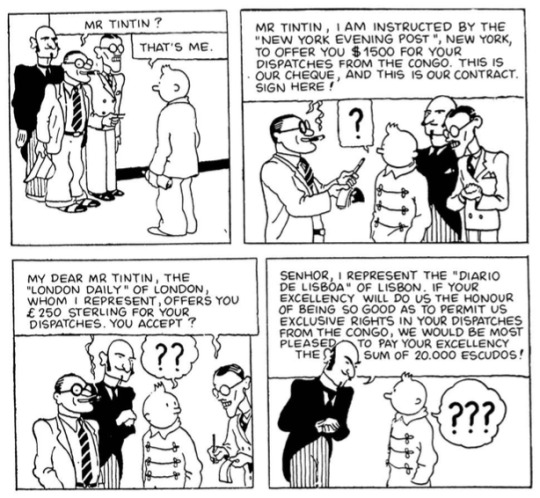
(Congo pg. 17)
Now, I'd had a theory that the series just became too plot-focused to keep pausing for references to Tintin's writing, but Reddit user XenophonOfAthens made a good point about Herge being forced to pause discussion of the press and current events after the nazis shut down Le Vingtieme, thus moving Hergé and many of the same staff to the nazi-overseen Le Soir and Le Soir Jeunesse. Tintin had been introduced as Le Petit Vingtieme's boy reporter who child readers could follow along with, but now with a new (heavily monitored) publication, mentions of the "boy reporter" slowly phased out.
One of the more significant edits to Tintin's reporting comes in Cigars of the Pharaoh. Sheik Patrash Pasha originally says he's followed Tintin's adventures for "several years" and presents a then-new Vingtieme publishing of Tintin in America.
In the colour edition, he instead presents Destination Moon. This album was in production at the time of the redraws, and it was one of the first albums to be published outside of Europe...but now Tintin's reaction is especially visceral, since that album involves him going to the moon with two people he hasn't met yet.
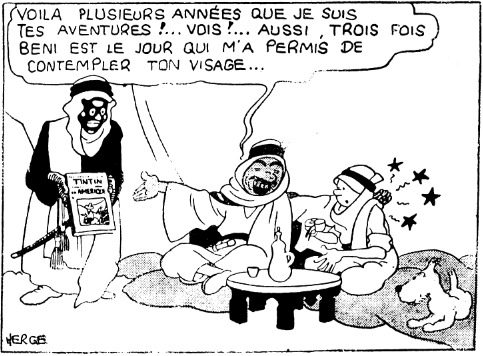
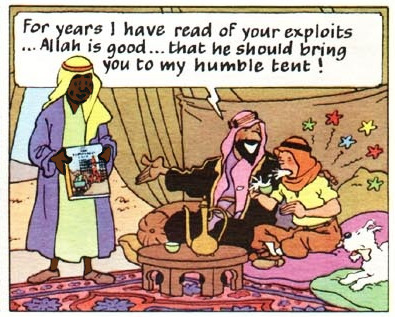
(Cigars B&W pg. 39, Casterman pg. 15. I also gave the Sheik's servant in the latter a quick edit because it was somehow worse than the 1933 version)
The last reference to Tintin's reporting for a long while was in The Broken Ear. We are now in the Soir era:

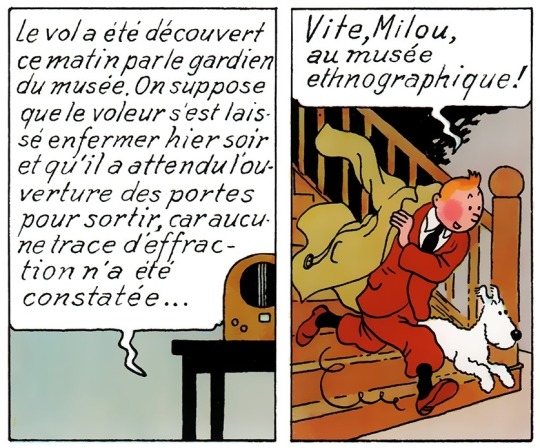
(Broken Ear pgs. 2)
This line never made it past the newsprint version. Tintin hears the news about the museum theft, and originally, he remarks that it'll make for a nice report...but in the reprint, he's just declaring that he'll go to the museum. I feel like the wording in the original could have referred to something specific about the comic's run in Le Soir Jeunesse, but it also could have been removed under the assumption that the reader would be going into this book knowing Tintin is a reporter. He does have a notepad with him through the rest of the page, but without that context, he just seems like a busybody.
I feel like there were a lot more references to his reporting in Le Journal Tintin, which is where the comic moved its publication to. This adds credence to the possibility that readers would be picking up these books knowing Tintin was a reporter, thus it being less of a focus within each album's plot. There do seem to be little hints throughout the albums about Tintin being a reporter...one of these is a moment in Explorers on the Moon where Tintin describes the moon's surface to ground control, and as a writer myself, this to me feels like him gathering his words for a future story:
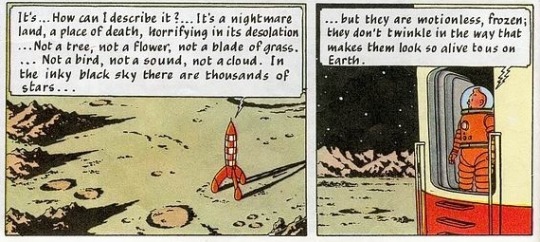
(Explorers pg. 24)
However, Tintin's reporting is brought up in an album one more time, decades later, in Picaros. Tintin is referred to as a reporter on televised news, so this is at least some confirmation that he does submit journalist work, at least off-camera or between albums:

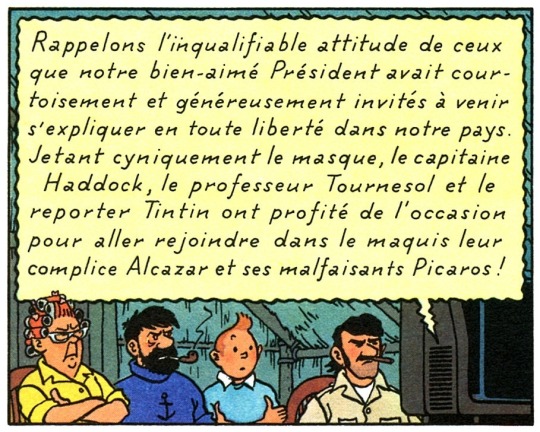
(pg. 47)
In short, Tintin's reporting started to fade off suspiciously during an era where nazis were breathing down Hergé's neck, then got a little lost in translation, and then ultimately came back.
My theory for Tintin's reporting slowly becoming less important in the albums happened either due to 1. Hergé and co. becoming more interested in writing about other things, 2. the series being moved to a vanity publication that discussed Tintin being a reporter outside of the canon comics, or 3. it got phased out during the Le Soir era because Hergé's supervisors didn't want to promote a gonzo journalist as a hero during a time with heavy political censorship and turmoil. It's completely up in the air.
77 notes
·
View notes
Note
It's been ages since I've seen Band of Brothers but I'd love to know who your favorite(s) is/are and some headcanons you have for them! 🥰
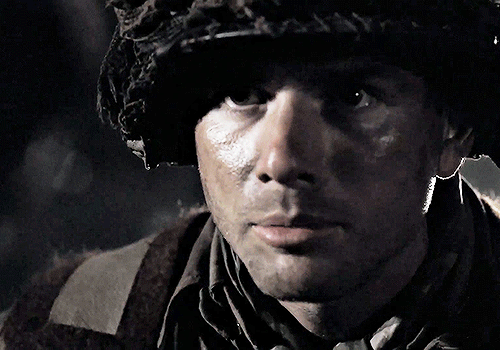
Ahh Steph, this is such a hard question!! I'm so glad you asked though because I LOVE talking about Band of Brothers. I'm getting my bestie to watch it right now and it's been a whole experience haha!
But if I had to choose a few favorites, here's my lineup:
Ronald Speirs: Listen, the first time I laid eyes on this man, I decided he was the man for me and no one has ever come close in the lineup since.
Dick Winters: A precious angel who has never done anything wrong in his life
Joseph Liebgott: My problematic murder child who I adore
Bill Guarnere: Ride or die for life and I respect the hell out of him for it
Carwood Lipton: He literally did not get paid enough for everything he did and put up with lol
I obviously like the others a lot, but these 5 have a special place in my heart haha! That being said, here are some general headcanons + a few relationship headcanons (since you didn’t specify haha) that I have about them!
Ronald Speirs:
-History NERD who collects a bunch of rare volumes of books
-Is surprisingly affectionate with friends, family, and relationships??
-Has a collection of baseball cards
-Remembers, like, one song on the piano and it’s Fur Elise.
-Is into writing love letters and keeps every single letter he’s ever been sent. Sentimental KING.
Dick Winters:
-Is really into baths with essential oils and has a whole skin care routine.
-Was in the Boy Scouts of America and was an Eagle Scout.
-Likes to see museums and definitely would go on a museum date where he info-dumps.
-Goes to rallies and marches for women’s rights because he drinks his respect women juice.
-Has a great sense of fashion and consistently gives the best compliments.
Joseph Liebgott:
-Likes cooking with his sisters and misses getting to spend time with them
-Memorizes music really quickly so he always knows his S/O’s fave songs
-Competitive relationships where he can have fun with his S/O is even better.
-Once punched a guy in the face because said guy insulted his little sister.
-Failed his driving test twice in high school but lied about it and faked forms to be a cab driver.
Bill Guarnere:
-Never had a girlfriend in high school because all of his older sisters warned him against it.
-Was a football player who went to state.
-Learned how to swim late in life and is only slightly embarrassed by it.
-Was voted most charismatic when he graduated. And also most kissable haha.
-Has a slightly guilty conscience and can never lie to his momma. Just the facts.
Carwood Lipton:
-Reads up on social issues and tries to stay informed to have opinions.
-Volunteers his time at soup kitchens and domestic violence shelters.
-Keeps a lock of his S/O’s hair in a locket that he wears.
-Wants to be a dad so badly one day.
-Has always easily made friends and everyone just likes him a lot.
#band of brothers imagines#band of brothers headcanons#band of brothers asks#band of brothers x reader#band of brothers#dick winters headcanons#dick winters imagines#dick winters x reader#dick winters#ronald speirs x reader#ronald speirs#ron speirs#joe liebgott#joseph liebgott#bill guarnere#carwood lipton x reader#carwood lipton
38 notes
·
View notes
Text
This Chinese American Aviatrix Overcame Racism to Fly for the U.S. During World War II
A second-generation immigrant, Hazel Ying Lee was the first Chinese American woman to receive her pilot’s license
by Susan Tate Ankeny - Smithsonian magazine, April 23, 2024

Hazel Ying Lee (right) and fellow pilot Virginia Wong (left). Courtesy of the Museum of Chinese in America, New York City
Hazel Ying Lee circled the biplane, looking for anything suspicious. Missing something on a precheck could cost you your life. She checked the engine and confirmed that no oil had collected in its lower cylinder.
Starting a Fleet biplane involved choreography. Lee grasped the propeller with one hand and pulled it backward. “Just walk it through. You don’t need to use force,” her instructor, Al Greenwood, yelled from the cockpit. She repeated the process four times; each time, she heard the click that told her she’d done it correctly. Then, with both hands on the propeller, she raised her left leg forward. Swinging it behind her for leverage, she pulled, and the unique thumping that identified the Kinner engine began.
After climbing onto the wing and into the cockpit, Lee inspected the instrument panel, starting with the fuel. The tank held close to three hours of fuel when full. If a car ran out of gas or had engine trouble, the driver could pull to the roadside. In flight, the best you could hope for was to find a good field, and quickly.
As 19-year-old Lee performed her preflight check in July 1932, Greenwood’s other training biplane, calledthe Student Prince, taxied down the runway, piloted by one of the Chinese Flying Club of Portland boys earning solo hours. Founded in 1931, Greenwood’s school trained Chinese American pilots to go to China and help defend against the invading Japanese.
These young men would become a vital part of Generalissimo Chiang Kai-shek’s stand against the invasion. As the head of China’s Nationalist government, Chiang and his party were trying to establish control in a nation divided among revolutionists, nationalists, Indigenous warlords, and a developing communist army and government. Now, Japan seemed determined to take China’s resources. Many Chinese Americans supported Chiang and believed he would help China emerge from years of strife and discord.
China’s fledgling air force, with barracks and hangars still being constructed in the north, was easily defeated by the Imperial Japanese Army Air Force. The Chinese needed pilots. Delegates traveled to the United States to scout out flying schools that could teach young Chinese American pilots to fly for China. Across the country, branches of the Chinese Consolidated Benevolent Association (CCBA), a group made up of local merchants and businessmen, agreed to help raise funds to train the young men.
youtube
The association was established in 1882 with the purpose of aiding and protecting Chinese Americans by providing assistance with housing, jobs and other issues that arose. Portland residents Chan Lam and Ting Lee made impassioned speeches to raise money for an aviation school, ultimately raising enough money to sponsor 36 local students. Chinese flight schools opened not only in Portland but also in Boston, San Francisco, Los Angeles and other cities across the country. In total, around 200 Chinese American pilots would undergo training at these schools before joining China’s defense against Japan. Before a student was accepted into the program, he had to pledge his life to China, to the interests of China and to Chinese aviation. The pledge to die for China would take precedence over any personal relationships that might develop.
‗‗‗‗‗‗‗‗‗‗‗‗‗‗‗‗‗‗‗‗‗‗‗‗‗‗‗‗‗‗‗‗‗‗‗‗‗‗‗‗‗‗‗‗‗‗‗‗‗‗‗‗‗‗‗‗
Greenwood had purchased the Prince exclusively for the students in his Chinese flying school. He was essentially running two businesses simultaneously. With the new school under his direction, most of his time was spent training young men for combat in China, but he continued to give private flying lessons to students like Lee.
Greenwood’s first class of 15 boys quickly became idols to Lee. For as many hours as she could spare, she watched them practice. They treated her like a kid sister, though all of them were about the same age, and good-naturedly tolerated her enthusiastic antics and questions. She was fun to have around, laughing and playing tricks on them, with a wide smile and deep-voiced wisecracks.

A 1943 photograph of Lee, then serving in the WASPs. Courtesy of Texas Woman's University Collection

Lee stands next to the Student Prince in 1932. Public domain via Wikimedia Commons
Lee had kept the photo of the first class that appeared in the Oregonian newspaper in January 1931. Looking like a motley crew of street urchins, the young men posed in front of the Prince, uncertain of what they were in for before Greenwood began his process of transforming them into pilots bound for war.
Lee had never been among others who shared her passion for aviation. Flying was all that Greenwood’s students talked about, and they knew as much about airplanes—and sometimes more—than experienced pilots. It was practice that they needed, practice flying. And Greenwood would provide it.
The “boys,” as Greenwood called them, proved to be able students, a little heavy on the control stick at first, but never lacking courage or a willingness to try anything. Training required ten hours of primary work and ten hours of advanced aerobatics from each student—an enormous task for one instructor. Other pilots were hired to provide instruction to the students.

Lee (in white) attends an air show in Shanghai in 1936. Public domain
Greenwood peppered his instruction with stories of his exploits, like one about his narrowest escape, to demonstrate the deadly consequences of fear. While practicing spins with a student, he’d turned the plane over at 7,000 feet and let it spin for about 5,000 feet. The student grabbed the stick, panicking, and, as a magazine article about Greenwood described it, “began to do things, all of which were wrong,” while using up nearly every one of the remaining 2,000 feet before Greenwood finally regained control—just before the wheels hit the tips of the grass. Controlling fear was essential no matter what happened in the air.
‗‗‗‗‗‗‗‗‗‗‗‗‗‗‗‗‗‗‗‗‗‗‗‗‗‗‗‗‗‗‗‗‗‗‗‗‗‗‗‗‗‗‗‗‗‗‗‗‗‗‗‗‗‗‗‗
Born in Portland in 1912, Lee was the second of eight children born to Chinese immigrants. After she discovered her love of aviation at age 19, Lee began dressing like a flier, in baggy pants tucked into riding boots. People stared and pointed, talking behind their hands. “There’s the girl who is learning to fly.” “So foolish.” “Her poor mother.”
One evening, Lee and her friend Elsie Chang sat on the schoolyard grass in the gathering twilight, while Lee dramatically explained everything about flying, as if she were taking Chang along for a ride. Lee described what she could see while flying, how she steered the airplane, how the air made the plane rock and bounce, and all the dangers that needed to be avoided, like stalling on a landing. To Chang, it all sounded terrifying.
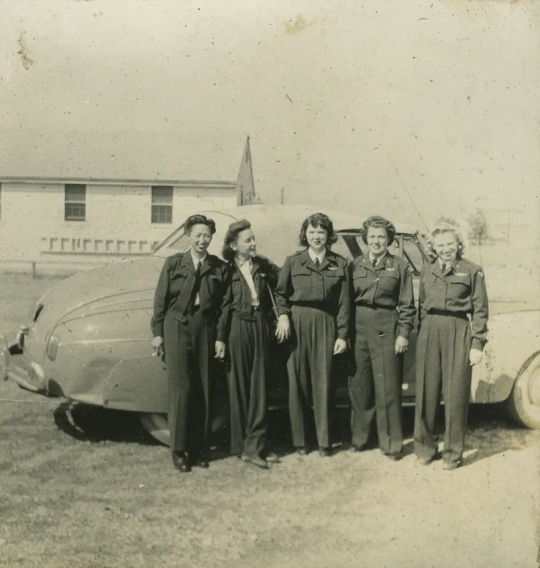
Lee (far left) served in the WASPs during World War II. Courtesy of Texas Woman's University Collection
Lee was such a good storyteller that Chang closed her eyes and felt the wind and the weightlessness and heard the engine and smelled the trees in the air aloft. They fell back on the grass and stared up at the darkening sky, waiting for the first star to flicker.
Lee told Chang that no other Asian American woman had a pilot’s license in the United States. She was going to be the first.
Lee counted the minutes until she could get back in an airplane, with the wind in her face and the lulling rumble of the engine to soothe her. She loved the speed, the rhythmic, percussive thump of the engine, the rush of air surrounded by the silent expanse of sky. Lee experienced a new kind of solitude. Away from her family and the tight quarters of a home filled with younger siblings, an elevator operator job where she had to try to be invisible, she was alone without any expectations or judgments. It didn’t matter that she was of Chinese descent. No one could see her race; no one could see her gender. In the sky, she wasn’t Chinese or American, man or woman, visible or invisible. She was just herself. In the sky, she felt limitless.
Lee refused to be tied to a home and children when there were more exciting things to do. She saw how conformity ruled women’s lives, offering a suffocating security in return. Women moved from their fathers’ homes to their husbands’, where their sons would have more power than they ever would. For most women, groomed to deny their own capabilities, to distrust themselves and defer to men, the decision to fly was fraught with fears, not only of flying but also of being independent. In an age when women were encouraged to stay grounded, Lee’s desire to fly was the ultimate expression of individuality. A husband might insist she give up flying, and that was something she would never do.

Lee reviews her performance after a session in a Link trainer. Public domain via Wikimedia Commons
If Lee could convince Greenwood and the CCBA to accept her into the next class of students training to go to China, she would sign the pledge without hesitation. To fly against the Japanese invaders would be the ultimate experience and worthy of any sacrifice. She’d die in battle fighting the enemy without any regrets. But the Chinese Flying Club, like all the related programs across the country, didn’t allow women. Lee decided that needed to change. There were few opportunities for a Chinese woman already. If she wasn’t admitted to Greenwood’s flying school, her future options were not just limited, they were unthinkable.
‗‗‗‗‗‗‗‗‗‗‗‗‗‗‗‗‗‗‗‗‗‗‗‗‗‗‗‗‗‗‗‗‗‗‗‗‗‗‗‗‗‗‗‗‗‗‗‗‗‗‗‗‗‗‗‗
In August 1932, Greenwood’s first class of 15 students eagerly awaited their departure for China, still heady from newspaper interviews and farewell speeches delivered at banquets in their honor. Four of the original 19 had failed to complete the class due to physical handicaps such as colorblindness. The proud graduates ready to embark on the adventure of a lifetime posed in front of the Prince in two rows, wearing tentative smiles and looking like boys not used to being photographed. Most wore ties, a few wore crewneck sweaters over white shirts, and several wore the bomber-style zip-up jackets popular at the time. They had learned more than flying under Greenwood’s guidance; they now believed themselves to be confident young men, no longer boys, ready to fight a war and, if necessary, die for China.
While the men of the CCBA wondered if these kids would have the toughness required to survive combat, Greenwood expressed an unwavering faith in his students. In an interview with Webster A. Jones of the Oregonian, Greenwood tried to deflate the accepted belief that people of Chinese descent could not possibly be as capable as white American pilots. “Chinese make rattling good fliers,” he said. “This myth about Orientals not being able to fly is pure bunk. They are as good as Americans—or other Occidentals—in natural ability, and they are superior in a lot of ways.”
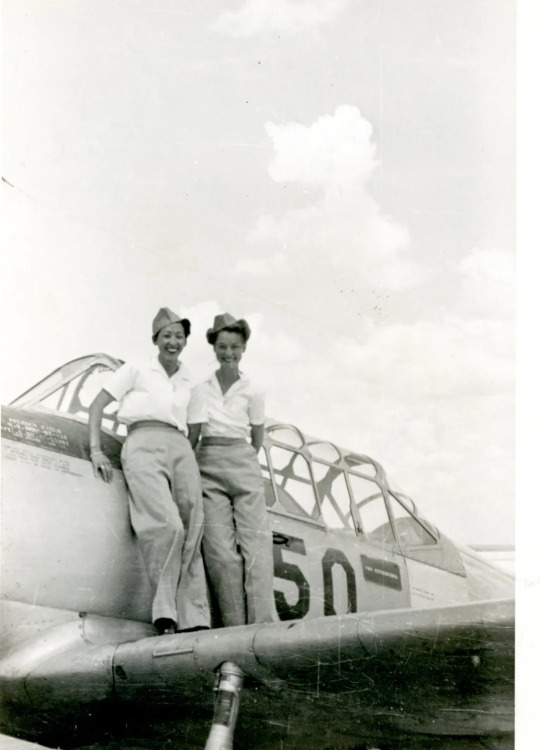
Lee (left) and Geneva Slack in 1943. Courtesy of Texas Woman's University Collection

L to R: Faith Buchner, Lee (standing on the wheel) and Grace Clark wearing “zoot suits” in 1943. Courtesy of Texas Woman's University Collection
After the graduates were photographed, Greenwood invited his other flying students to pose for a photo. Lee sauntered over to stand in front of the Prince,wearing wide khaki jodhpurs tucked into black riding boots, a polo shirt and a flight vest. Her goggles had been pushed up onto her flight cap. She took a drag from her cigarette and leaned back on the wing.
Greenwood recognized Lee’s transformation. She moved in a slow, confident stride, with a graceful swagger. Over the summer, she had made rapid progress and would soon fly solo. In a few short months, she had come into her own, and in doing so, had become something completely unique. Greenwood understood her need to be first, to compete with the boys and the girls, too. He smiled and nodded toward her as the camera shutter snapped.
Lee was as talented as any of the male fliers, but the CCBA had not yet granted permission. Since the Chinese elders and businessmen supporting the school paid all the training expenses for the students, they had to be convinced that girls were worth the investment. Greenwood’s latest argument, that the grant to train 36 students had not stipulated they be boys, proved incorrect. The contract called for “young men.” He would have to convince them that Lee was a crack pilot worthy of their financial investment. She had to pass her flying test to receive her license first, but that wasn’t going to be any trouble for her.
Greenwood became a fierce advocate for Lee, telling the Oregonian that she had received the same training as her male counterparts and was just as capable as them, if not more so. He believed Lee would prove his long-held belief that flying involved more finesse than muscle, and that keen intelligence was more important than brute strength.
Besides helping China defend itself against the Japanese invasion and having the opportunity to fly, Lee had another reason for wanting to go to China. Her father’s children from a previous marriage—her half-siblings—as well as her aunts, uncles and cousins still lived in the village where her father had grown up. This could be her chance to fulfill her dream of visiting her father’s homeland.

Ferrying trainees being briefed in the Ready Room. Lee appears at the center of the back row. Courtesy of Texas Woman's University Collection
On October 24, 1932, Lee passed the rigorous Department of Commerce pilot examination. Having also accumulated 50 flying hours, half of which were solo, Lee was granted a private pilot’s license. The document described her as a 5-foot-3, 117-pound woman. On November 1, the Oregon Journal reported on Lee’s achievement with the headline “Portland Elevator Girl Masters Flying and Gets License.” The reporter wrote, “The fifth floor of the H. Liebes & Co. [department store] was not high enough for Hazel Lee, 20, elevator operator there, so she got up early mornings to learn to fly an airplane. … Miss Lee took an airplane ride a year ago, got interested, and now that she can fly, she plans someday to go to China and interest women there in aviation.”
Lee was, in fact, the first Chinese American woman in the U.S., not just in Oregon, to earn a pilot’s license. (Katherine Sui Fun Cheung, born in China in 1904, earned her pilot’s license a few months before Lee and was the first woman of Chinese descent to do so in the U.S.; she later became a naturalized citizen.) Over the next decade, Lee would fly planes in both China and the U.S., becoming one of just two Chinese Americans accepted into the Women Airforce Service Pilots (WASP) during World War II. She died at age 32 on November 25, 1944, two days after her plane collided with another aircraft and burst into flames. “Of the 1,102 women who [flew] in the WASP program, 38 died in service,” notes the Federal Aviation Administration. “Lee was the last.”
Adapted from American Flygirl by Susan Tate Ankeny. Published by Kensington Publishing Corp. Copyright © 2024 by Susan Tate Ankeny. All rights reserved.
#Hazel Ying Lee#Women Airforce Service Pilots#WWII#American Flygirl#Susan Tate Ankeny#Smithsonian magazine#April 2024#long post#Youtube
9 notes
·
View notes
Text
DCRC Week #3 (Part 2)

Aight y'all now it's time for Don Rosa's The Son of the Sun let's get it
Unlike the PKNA chapters we've read so far I actually HAVEN'T read this comic before so this will, in fact, be a true Live Puffy Reaction™
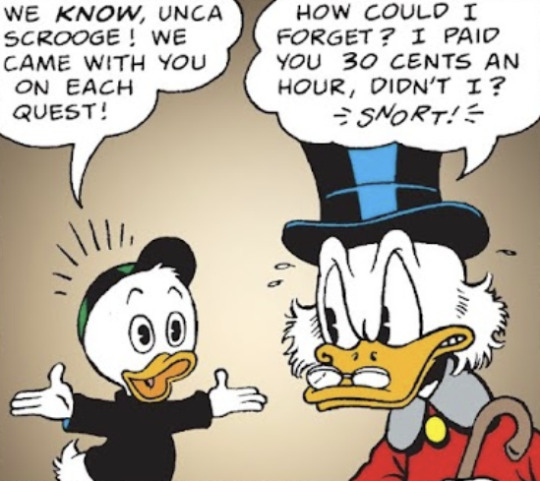
You're telling me THIS Scrooge actually pays his child nephews for their labor but DT17 Scrooge doesn't?? And he's supposed to be the nice one...
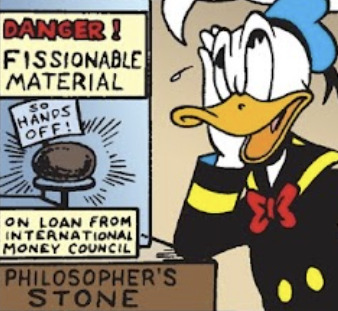
A philosopher's stone eh..... wonder how he got that....... I'm thinking about Fullmetal Alchemist sorry-

wait are they gonna kiss ewww
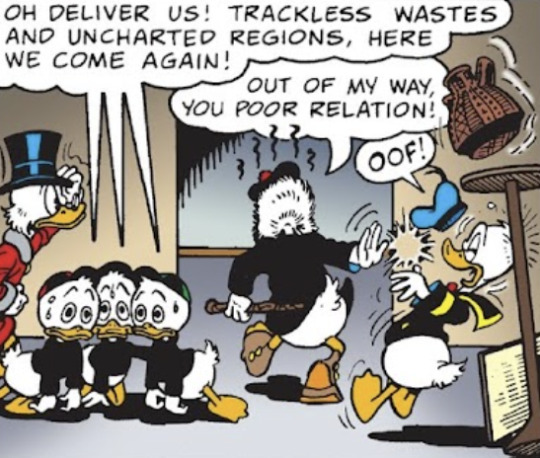
You can tell how much the boys love going on adventures from their reaction here, it really is the best of enrichment for them. Now hurry up and get in the plane.
Also poor Donald getting smacked around when all he's done is just fucking stand there 💀

Why the fuck does the Junior Woodchuck guidebook have so much information about the Incan empire, to the point it even knows more than the guy at the museum that studied it? I mean I wasn't allowed to be a boy scout (on account of the fact that I'm a girl) so I'm lacking a frame of reference here. Maybe the actual boy scout handbook had like 200 pages dedicated to every major empire in pre-Columbian America idk.
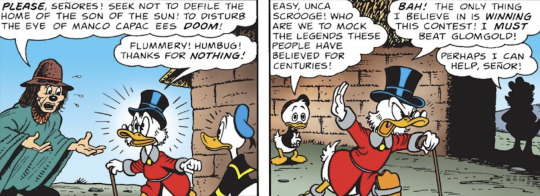
Scrooge showing up like FUCK the natives just gimme my damn gold

WOOK OUT!!! HE'S GOT A GUuUuUUN!!!!!!

Man where's Launchpad when you need him 😭 not that his flying would be much better but y'know


What a silly and whimsical old fellow he is after holding a family of mostly children at gunpoint for multiple days! Look at him frolic around!!

Nevermind he just had all his joy and whimsy revoked sucks to suck
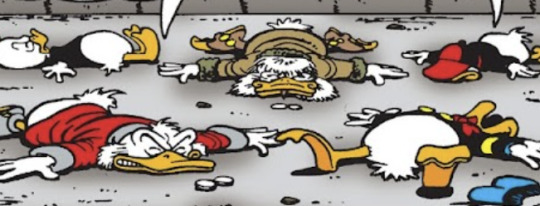
flat


Love how cute and happy the family looks in these panels (plus a bonus miserable Glomgold as a treat)
I REALLY need to read more of Rosa's works (which is to say that I have a giant copy of Life and Times that hasn't been cracked open yet because I've been waiting for the right opportunity to be able to actually sit down and go through it). I'm also taking this opportunity to plug Don Rosa's twitter account actually cause it's my favorite social media page ever. It's not even run by Rosa himself like he has a team that posts for him and they just upload pictures of him sleeping and eating breakfast and stuff, it's literally the best you guys.
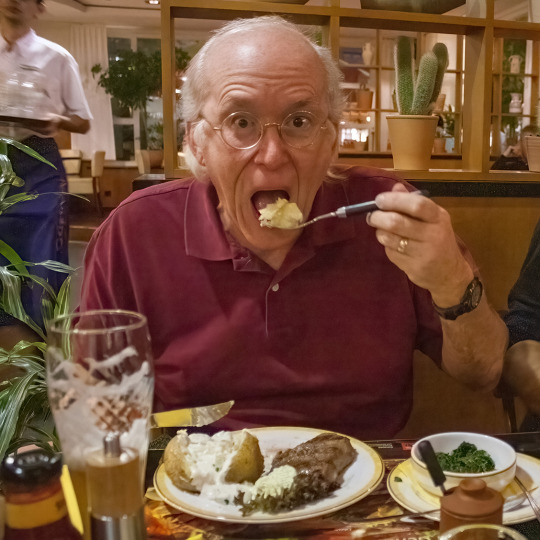

#I'm not posting this slightly late shut up SHUT UP I've been a busy bee#dcrc#dcrc week 3#duck comics
5 notes
·
View notes
Photo
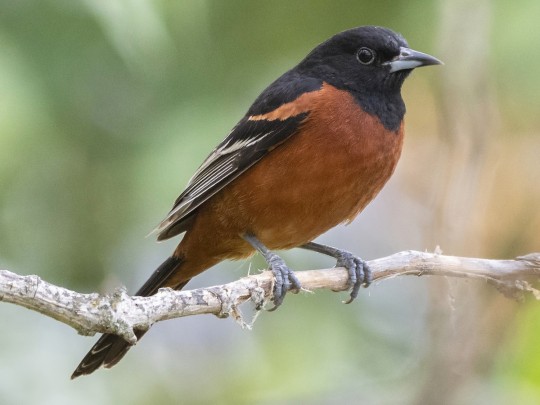



Hispanic Heritage Month: Louis Agassiz Fuertes
In a departure from our usual uncharismatic animals, and to mark the end of Hispanic Heritage Month in the US, I’d like to discuss a man easily comparable to Audubon: Louis Agassiz Fuertes.
Fuertes was born in New York to Puerto Rican parents in 1874. His father was an astronomer and civil engineer, and recognised his son’s talent and passion for birds at an early age; this revelation might have been aided by an incident involving young Fuertes tying a live owl to the kitchen table. Fuertes became an Associate Member of the American Ornithologists Union at age 17, and was mentored at Cornell University by Elliott Coues, the nation's leading ornithologist.
After graduating, Fuertes went on expeditions to document new species. These expeditions were led by a number of famous explorers, including artist Abbott H. Thayer, financier E. H. Harriman, and zoologist C. Hart Merriam. As he established himself as an ornithologist and illustrator in his own right, Fuertes continued to travel the world, covering much of North America and venturing to other countries like the Bahamas, Jamaica, Canada, Mexico, Colombia, and Ethiopia in pursuit of new species.
Between these travels Fuertes collaborated with the curator of American Museum of Natural History, Frank Chapman, to create field guides, dioramas, and book illustrations. Fuertes also discovered a species of oriole, known now as Fuertes's oriole or the orchard oriole (Icterus fuertesi). Beginning in 1923 Fuertes regularly lectured on ornithology at his alma mater, Cornell. He completed his last expidition in 1926-27, when he accompanied W. H. Osgood on the Chicago Field Museum’s trip to Ethiopia and produced some of his most famous works. Shortly after his return, Fuertes was killed in a train accident. He was 53 years old.
Fuertes’s legacy continues on in two species of bird: the Orchard Oriole and Fuertes's parrot (Hapalopsittaca fuertesi), which was rediscovered in 2002 after being thought to be extinct. To honor his adventurous spirit, the Boy Scouts of America made Fuertes an Honorary Scout after his death in 1927. The Wilson Ornithological Society established the Louis Agassiz Fuertes Award in 1947, and he has been credited with influencing other later wildlife artists.
If you like what I do, consider leaving a tip or buying me a ko-fi!
38 notes
·
View notes
Photo
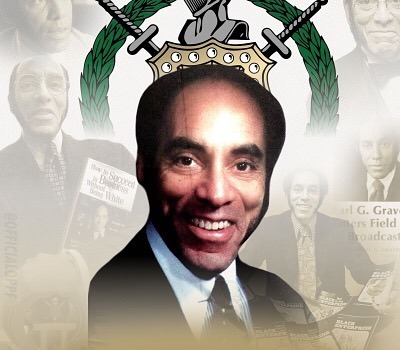
Earl Gilbert Graves Sr. (January 9, 1935 – April 6, 2020) was an entrepreneur, publisher, businessman, philanthropist, and advocate of African-American businesses. A graduate of Morgan State University, he was the founder of Black Enterprise magazine and chairman of the media company Earl G. Graves, Ltd. He was the director for Aetna and an Executive Board member of the Boy Scouts of America. Born in Brooklyn, He grew up in Bedford-Stuyvesant. A member of the Omega Psi Phi Fraternity, he received a BA in Economics from Morgan State University. He was an ROTC graduate and attended Airborne and Ranger Schools. Having written a letter to the DNC, he became a volunteer for the presidential campaign of Lyndon B. Johnson. His work with the party allowed Him to serve as administrative assistant to newly elected Senator Robert F. Kennedy. Following the assassination of the senator, he would land a seat on the advisory board of the SBA. He started Earl G. Graves, Ltd., and under that holding company, he began the Earl G. Graves Associates management consulting firm. In August 1970, the first issue of Black Enterprise magazine would hit newsstands. Earl G. Graves, Ltd. would grow to include several divisions including publishing, marketing, radio, television, and event coordinating arms. The firm is the co-owner of the private equity fund Black Enterprise Greenwich Street Corporate Growth Fund, an equity partnership formed with Travelers Group, Inc. The fund aims to invest in and promote minority-operated businesses. He served as CEO of the Pepsi-Cola bottling franchise in DC. He has held other board and director memberships with several corporations including AMR Corporation, Daimler AG, Federated Department Stores, and Rohm and Haas, as well as a board member of the American Museum of Natural History and Hayden Planetarium in New York City. He was a member of the Board of Trustees of Howard University. #africanhistory365 He married Barbara Kydd Graves (1969-2012) and they had three sons. #africanexcellence #omegapsiphi https://www.instagram.com/p/CnMe0lVrnop/?igshid=NGJjMDIxMWI=
6 notes
·
View notes
Text

@abeautifulmencgerie said: 𝓙𝓸𝓾𝓻𝓷𝓪𝓵 ー send 📖 for a journal entry my muse wrote about yours. (for steve)
Sheila hummed as she wrote in her journal--she didn't really do much writing since high school.
Steve Rogers? How can I just describe him? He reminds me of Hercules--the Disney version. Not the Greek mythology version where his mom, Hera, makes him go crazy and he ends up killing his wife and decides to do the 12 Labours as his own form of self-punishment.
Anywho, Steve--Wonder Boy--he’s this big, clumsy, awkward, hunky, blond dork who happens to have godlike strength. Don’t get me wrong, he’s really handsome and the ideal perfect man--but honestly, I wanna know more about the guy. More about his past--and just everything around it.
I went to the Captain America museum--the history about him is interesting. I was surprised to see he was just his skinny little guy when he started--and I gotta admit. He was cute before. If I lived in his time, I would’ve talked to him--well, I probably would’ve dressed like Scout from To Kill a Mockingbird back then: overalls and boys’ clothes.
Anywho--Steve. I’d like to know more about the man behind the shield. Behind all that Star-Spangled attire, who IS Steve Rogers? I’d like to know what movies he liked--like Snow White, movies with Shirley Temple, the Marx Brothers, the Three Stooges. Oh! Music! I’d like to know what he liked--my grandparents played a lot of Bing Crosby, but that’s pretty much all I know. Just stuff about him growing up in Brooklyn--what did he like to do. Did he remember this part of history or that? I especially want to know his opinions about women--mainly Rosie the Riveter and all the women who took up jobs while the men went off to war. And what his opinions of women today--women working men’s jobs like in the military.
Anywho, I am excited to hear it all from the man himself.

#Quick With A Joke [reply]#abeautifulmencgerie; Steve Rogers#Holding Out for a Hero [Marvel verse]#hehe sorry it's really LONG#Sheila is a hell of a chatty Cathy--even when she writes.
2 notes
·
View notes
Text
Tulsa Day 3 Osage area
Today was a day out in Osage country seeing the tribal nations area and visiting the location of the film set "Killers of the Flower Moon". Initially our journey north into the region took us through several townships with native names and past many small nodding donkeys which reflect the areas oil industry. This was the background to the film released last year which documents the 1920s period of Osage history known as the Reign of Terror where native Indians were being killed to gain rights over their land and oil. We had already watched the film so Bob and Sally were taking us to Pawhuska, the location where the township of the film was based.
On our way into Pawhuska we saw a small museum signposted and decided to make a stop - what a gem! Not only did it tell of the oil in the area and of the Osage tribal chiefs and ways of t=life but for me the highlight was finding out that Pawhuska was the location for the very first Boys Scout troop in the USA. There were old documents, uniforms and some brilliant statues.
The story was that John Mitchell, who had been a chaplain to Baden Powell arrived in Pawhuska as a missionary in 1910, shortly after BP had founded scouting in UK and brought with him the ideas of scouting which he sold to both the parents and young people of the church. 19 young people enthusiastically formed a troop and scouting in USA was born. However, the Pawhuska troop didn't attend the incorporation ceremony for the Boys Scouts of America in Washington and another Troop was awarded the Charter as first. In 1956 Rev John Mitchell produced evidence of how the Pawhuska troop was organised and the BSA have now recognised Pawhuska as the first Troop.
Our next stop was lunch at The Pioneer Woman's Emporium in Pawhuska where we tried cheesy Grits and had a beef sandwich and salad, a lot less food than yesterday thankfully. Then it was a walk around the town to see the buildings used in the film then it was off to the Tallgrass Prairie Reserve.
The Prairies used to cover 14 states stretching from Canada to the south and over 142million acres of land. Now there is less than 4% of this area in only Kansas and Oklahoma. The Tallgrass Prairie reserve purchased 29,000 acres of ranch land in 1989 to recreate a functional tallgrass ecosystem using traditional methods including controlled burning and bison. Originally 300 bison were introduced and there are now 2300 or more bison and we got some lovely close up encounters.
Back in Tulsa we visited Bob and Sally's home for drinks and met Ryan and Liz, their son and his girlfriend (and Lucy the dog) and then it was out for our final meal with the family some sushi.
We have had an amazing time with Bob and Sally and its certainly set us up well for our travels.
Now its a question of trying to avoid the snow as we start to move west!
0 notes
Text
Odds & Ends: July 21, 2023
“Children Lost the Right to Roam in Just Four Generations.” This article takes a look at four generations in a family and sees how far the kids were able to wander from their home. As expected, the range of roaming shrunk as the generations progressed; a boy in 1926 could walk six miles from his home without adult supervision, while his great-grandson can go no more than 300 yards from his house.
It’s interesting. And sad. Reminded me of the series we did on the origins of overprotective parenting and the risks of not letting your kids do risky things.
Outfoxed! Our family likes to play card and board games to while away the time, and especially likes those that are easy to learn and fun for all ages. Outfoxed!, which we discovered a few years ago, fits the bill nicely. The game is good for young kids, but even now that Gus and Scout are 12 and 9, we’ll still bust it out from time to time. You work together to figure out which of a set of fox suspects stole a pie. It’s kind of like Clue. And actually, having been inspired by recently watching the wacky 1985 Clue movie, we’re about to move on to try that game for the first time.
“Ida Red” by Bob Wills and the Texas Playboys. I enjoy western swing music. It’s a genre that combines country music with the swing of jazz. The undisputed King of Western Swing was Bob Wills. Bob Wills and his Texas Playboys performed a radio show from Cain’s Ballroom here in Tulsa for several years. “Ida Red” is a good introduction to Bob Wills and the joys of Western swing. In the video, Bob Wills is the guy playing fiddle at the beginning and making those “awwww yeahhhh” noises throughout the song. It’s lit, as the kids say these days. Or at least said five years back.
The Wilderness Warrior: Theodore Roosevelt and the Crusade for America by Douglas Brinkley. There are a lot of biographies of Theodore Roosevelt out there. This particular tome is unique because it focuses on TR’s life as a conservationist and naturalist. You’ll see how the boy who collected animals and started his own natural history museum in his Manhattan brownstone would grow up to become a president who would set aside 230 million acres of American wilderness for posterity. Lots of great historical asides about the development of environmental law in the United States. Good book to listen to while you’re road tripping to a National Park.
Quote of the Week
Your levelers wish to level down as far as themselves, but they cannot bear leveling up to themselves. They would all have some people under them; why not then have some people above them?
—Samuel Johnson
The post Odds & Ends: July 21, 2023 appeared first on The Art of Manliness. http://dlvr.it/SsXRwr
0 notes
Text

This model of an outrigger canoe was presented to President Roosevelt by Troop 13 of the Boy Scouts of America in Honolulu, Hawaii. It was delivered to the White House by scouts Richard Noda and Hiroshi Daifuku. Roosevelt included the model in the inaugural display in the Naval Exhibition Room of the Roosevelt Library: https://fdr.artifacts.archives.gov/objects/627
#asian american pacific islander heritage month#aapi heritage month#hawaii#boy scouts of america#fdr#franklin d. roosevelt#gifts to the president#1930s#museum collection#museum from home#archives at home
16 notes
·
View notes
Text
“Minecraft™ Lied to Me!?”
On October 19, 2019, the Section of Anthropology once again had the pleasure of assisting the Education and Interpreter staff in awarding the BSA Scouts Merit Badge for archaeology. The Scouts spent the day learning how to excavate artifacts from dig boxes and creating mini-exhibits for museum visitors to enjoy. The mini-exhibits were focused on typology. Scouts were asked to organize lithics (mostly arrow heads and spear points) by physical characteristics. Stem and shoulder shape, cross section, and flaking styles are often used by archaeologists to categorize objects. Other basic morphological typology categories can rely on color, weight, or material.
The Scouts were asked to create labels for their mini-exhibits to explain the reasoning behind their classifications. Some Scouts organized objects by size, while others chose to compare the different shapes. One Scout was organizing objects by material, specifically obsidian. He asked if it was nearly indestructible like in Minecraft™ and I had to tell him that obsidian is actually volcanic glass that breaks pretty easily resulting in a conchoidal fracture, which is why people have made so many arrow heads and spear points out of it. He replied, “well, next you’ll tell me that it doesn’t create portals into a nether dimension.” Sorry Scout, to my knowledge it does not.

To investigate further into how obsidian is used in Minecraft™, I called the most knowledgeable gamer I know. My nephew, Zak, was happy to explain to me that in the game you combine lava and water to create obsidian blocks. This isn’t exactly true. Obsidian is formed when molten rock material cools so fast it cannot form a crystalline structure at an atomic level. It usually solidifies on the Earth’s surface, making it an extrusive rock. According to Zak, the obsidian in Minecraft™ can be used to create a very strong wall or to access the nether dimension that I had learned about from the Scout. Weapons are not made from it and it is very hard to break. In reality, obsidian is easily broken by human action and can also be worn down by the weather. This would make it a terrible substance from which to build a fortress. While obsidian is not used to build indestructible walls or portals, it is used to make surgical tools. It can be made sharper than steel and can be placed in scalpels for precision procedures. So, while the obsidian in Minecraft™is different than obsidian on Earth, at least it sparked a conversation.

The obsidian artifacts in this photo are a part of the educational collection maintained by the Section of Anthropology.
To learn more about the BSA Merit Badge for archaeology visit: https://meritbadge.org/wiki/index.php/Archaeology
To read another CMNH blog about obsidian visit: https://carnegiemnh.org/tag/emerald-obsidianite/
Amy L. Covell-Murthy is the Archaeology Collection Manager at Carnegie Museum of Natural History. Museum employees are encouraged to blog about their unique experiences and knowledge gained from working at the museum.
#Carnegie Museum of Natural History#Boy Scouts of America#Boy Scouts#Archaeology#Obsidian#Minecraft#Archaeology Merit Badge#Anthropology
25 notes
·
View notes
Photo

#DYK: The Boy Scouts of America was founded on Feb. 8, 1910?
From the JMM Collections: Rabbi Samuel Rosenblatt shakes hands with Eagle Scout, Don Cohen. (L-R) Allen Cohen (father), Rabbi Rosenblatt, Don Cohen, Anne Cohen (mother), & Hebrew School principal Harry H. Spritz, DDS, c. 1955/56. JMM 1999.20.13.
4 notes
·
View notes
Photo










Native American Day
What started at the turn of the century as an effort to gain a day of recognition for the significant contributions the first Americans made to the establishment and growth of the U.S., has resulted in a whole month being designated for that purpose.
One of the very proponents of an American Indian Day was Dr. Arthur C. Parker, a Seneca Indian, who was the director of the Museum of Arts and Science in Rochester, N.Y. He persuaded the Boy Scouts of America to set aside a day for the “First Americans” and for three years they adopted such a day. In 1915, the annual Congress of the American Indian Association meeting in Lawrence, Kans., formally approved a plan concerning American Indian Day. It directed its president, Rev. Sherman Coolidge, an Arapahoe, to call upon the country to observe such a day. Coolidge issued a proclamation on Sept. 28, 1915, which declared the second Saturday of each May as an American Indian Day and contained the first formal appeal for recognition of Indians as citizens. The year before this proclamation was issued, Red Fox James, a Blackfoot Indian, rode horseback from state to state seeking approval for a day to honor Indians. On December 14, 1915, he presented the endorsements of 24 state governments at the White House. There is no record, however, of such a national day being proclaimed.
The first American Indian Day in a state was declared on the second Saturday in May 1916 by the governor of New York. Several states celebrate the fourth Friday in September. In Illinois, for example, legislators enacted such a day in 1919. Presently, several states have designated Columbus Day as Native American Day, but it continues to be a day we observe without any recognition as a national legal holiday. In 1990 President George H. W. Bush approved a joint resolution designating November 1990 “National American Indian Heritage Month.” Similar proclamations, under variants on the name (including “Native American Heritage Month” and “National American Indian and Alaska Native Heritage Month”) have been issued each year since 1994.
Source
#Klahowya Village#totem pole#Stanley Park#Vancouver#British Columbia#Montreal First Peoples Festival#Lower Fort Garry National Historic Site of Canada#Canada#food#restaurant#Navajo#Diné#Naabeehó#Arizona#travel#Montezuma Castle National Monument#Native American Day#14 May 2022#NativeAmericanDay#second Saturday in May#Wabanki Canoe#Ottawa#The Gather-Ring by Manuel Báez and Charlynne Lafontaine#Anishinaabe Scout by Hamilton MacCarthy
2 notes
·
View notes
Text
One of the very proponents of an American Indian Day was Dr. Arthur C. Parker, a Seneca Indian, who was the director of the Museum of Arts and Science in Rochester, N.Y. He persuaded the Boy Scouts of America to set aside a day for the “First Americans” and for three years they adopted such a day. In 1915, the annual Congress of the American Indian Association meeting in Lawrence, Kans., formally approved a plan concerning American Indian Day. It directed its president, Rev. Sherman Coolidge, an Arapahoe, to call upon the country to observe such a day. Coolidge issued a proclamation on Sept. 28, 1915, which declared the second Saturday of each May as an American Indian Day and contained the first formal appeal for recognition of Indians as citizens.
The year before this proclamation was issued, Red Fox James, a Blackfoot Indian, rode horseback from state to state seeking approval for a day to honor Indians. On December 14, 1915, he presented the endorsements of 24 state governments at the White House. There is no record, however, of such a national day being proclaimed.
The first American Indian Day in a state was declared on the second Saturday in May 1916 by the governor of New York. Several states celebrate the fourth Friday in September. In Illinois, for example, legislators enacted such a day in 1919. Presently, several states have designated Columbus Day as Native American Day, but it continues to be a day we observe without any recognition as a national legal holiday.
In 1990 President George H. W. Bush approved a joint resolution designating November 1990 “National American Indian Heritage Month.” Similar proclamations, under variants on the name (including “Native American Heritage Month” and “National American Indian and Alaska Native Heritage Month”) have been issued each year since 1994.
President Biden's 2021 proclamation is here.
#National Native American Heritage Month#Native American Heritage Month#National American Indian and Alaska Native Heritage Month#American Indian Day#Bush#George Bush#George H.W. Bush#President Bush#Biden#Joe Biden#President Biden#POTUS
11 notes
·
View notes
Photo


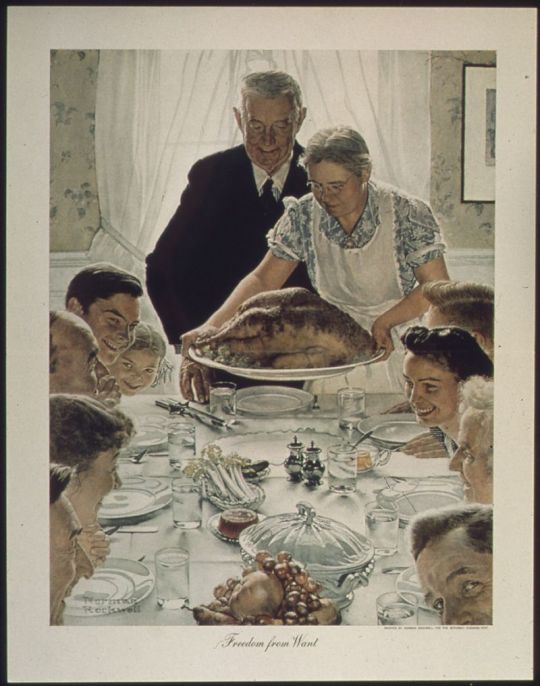
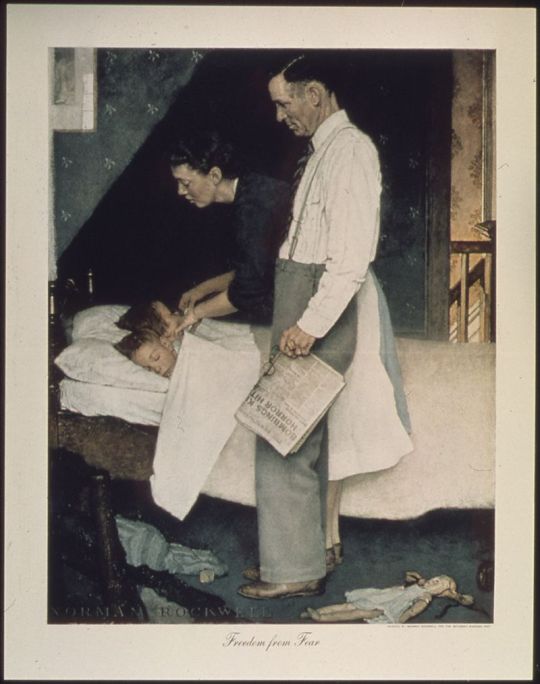
February 20, 1943 – The Saturday Evening Post publishes the first of Norman Rockwell's Four Freedoms in support of United States President Franklin Roosevelt's 1941 State of the Union address theme of Four Freedoms.
The Four Freedoms is a series of four 1943 oil paintings by the American artist Norman Rockwell. The paintings—Freedom of Speech, Freedom of Worship, Freedom from Want, and Freedom from Fear—are each approximately 45.75 inches (116.2 cm) × 35.5 inches (90 cm), and are now in the Norman Rockwell Museum in Stockbridge, Massachusetts. The four freedoms refer to President Franklin D. Roosevelt's January 1941 Four Freedoms State of the Union address in which he identified essential human rights that should be universally protected. The theme was incorporated into the Atlantic Charter, and became part of the charter of the United Nations. The paintings were reproduced in The Saturday Evening Post over four consecutive weeks in 1943, alongside essays by prominent thinkers of the day. They became the highlight of a touring exhibition sponsored by The Post and the U.S. Department of the Treasury. The exhibition and accompanying sales drives of war bonds raised over $132 million.
This series has been the cornerstone of retrospective art exhibits presenting the career of Rockwell, who was the most widely known and popular commercial artist of the mid-20th century, but did not achieve critical acclaim. These are his best-known works, and by some accounts became the most widely distributed paintings. At one time they were commonly displayed in post offices, schools, clubs, railroad stations, and a variety of public and semi-public buildings.
Critical review of these images, like most of Rockwell's work, has not been entirely positive. Rockwell's idyllic and nostalgic approach to regionalism made him a popular illustrator but a lightly regarded fine artist during his lifetime, a view still prevalent today. However, he has created an enduring niche in the social fabric with Freedom from Want, emblematic of what is now known as the "Norman Rockwell Thanksgiving".
Rockwell's Four Freedoms—Freedom of Speech, Freedom of Worship, Freedom from Want, and Freedom from Fear—were first published on February 20, February 27, March 6, and March 13, 1943 along with commissioned essays from leading American writers and historians (Booth Tarkington, Will Durant, Carlos Bulosan, and Stephen Vincent Benét, respectively). They measure 45.75 inches (116.2 cm) × 35.5 inches (90 cm) except Freedom of Worship which measures 46.0 inches (116.8 cm) × 35.5 inches (90 cm). Rockwell used live models for all his paintings. In 1935, he began using black-and-white photographs of these live models extensively, although he did not publicly reveal he did so until 1940. The use of photography expanded the possibilities for Rockwell who could ask models to pose in positions they could hold only for brief periods of time. He could also produce works from new perspectives and the Four Freedoms represented "low vantage point of Freedom of Speech, to close-up in Freedom of Worship, midrange in Freedom from Fear, and wide angle in Freedom from Want".
In 1939, Rockwell moved to Arlington, Vermont, which was an artist-friendly community that had hosted Robert Frost, Rockwell Kent, and Dorothy Canfield Fisher. Of the move from New Rochelle, New York, Rockwell said "I was restless ... The town [of New Rochelle] seemed tinged with everything that happened to me". In New Rochelle, he had both endured a divorce and run with a fast crowd. Artists John Atherton, Mead Schaeffer and George Hughes established residences in Arlington soon after Rockwell. The resident artists, Rockwell included, were mutually supportive and hired local citizens as their amateur models. Using photography and Arlington residents as models, Rockwell was able to capture what he referred to as "human-looking humans", who were generally working-class people, in an hour or so rather than hire professional models for the entire day. Rockwell paid his models modestly. Rose Hoyt, who was engaged for a total of three photographic sessions for Freedom of Speech and Freedom of Worship, earned $15 ($234.71 in 2019 dollars) for her sittings.
When the US entered the war in 1941, it had three agencies responsible for war propaganda: The Office of Facts and Figures (OFF), The Division of Information of the Office of Emergency Management (OEM), and Office of Government Reports (OGR). The OFF was responsible for commissioned artwork and for assembling a corps of writers, led by Librarian of Congress Archibald MacLeish. By mid-1942, the Office of War Information determined that despite the efforts of OFF in distributing pamphlets, posters, displays, and other media, only a third of the general public was familiar with Roosevelt's Four Freedoms and at most one in fifty could enumerate them. The Four Freedoms had been a "campaign to educate Americans about participation in World War II".
By 1942, Rockwell had been illustrating professionally for thirty years and was having a successful career. Additionally, by mid-1942 Rockwell's Gillis was becoming famous. Lorimer had been the editor of The Post from 1898 to 1936. He was followed by Wesley W. Stout for five years. In early 1942, Stout ran an article entitled "The Case Against the Jew", which led to advertising and subscription cancellations. The Post was rumored to be in financial trouble in 1942. Soon Stout was replaced by Hibbs who revamped the magazine.
On May 24, 1942, Rockwell was seeking approval for a poster design at The Pentagon because the Artists Guild had designated that he advocate for the U.S. Army Ordnance Department. Robert Patterson, who was then United States Undersecretary of War, suggested revisions. On the same day, he visited with Thomas Mabry of the Graphic Division of the War Department's Office of Facts and Figures, which coordinated war-themed posters and billboards. Mabry relayed the need for Four Freedoms artwork. Rockwell returned home pondering the Atlantic Charter, which had incorporated the Four Freedoms.
Rockwell remembered a scene of a local town meeting in which one person spoke out in lone dissent, but was given the floor, and was listened to respectfully, despite his solitary opposition. He was inspired to use this scene to illustrate Freedom of Speech, and Rockwell decided to use his Vermont neighbors as models for an inspirational set of posters depicting the themes laid out by Roosevelt the previous year in a Four Freedoms series. He spent three days making charcoal sketches of the series, which some sources describe as colour sketches. Rockwell's patriotic gesture was to travel to Washington, D.C. and volunteer his free services to the government for this cause. In mid-June, accompanied by Schaeffer, he took four charcoal sketches to Washington, where they stayed at the Mayflower Hotel, as the two sought commissions to design war art. During the trip, Rockwell was asked by the Boy Scouts of America to continue his annual creation of a new painting for their annual calendar by publishing representative Orion Winford. He was unable to hold Patterson's attention during their meeting, so he met with the new Office of War Information (OWI), where he was told "The last war you illustrators did the posters. This war we're going to use fine artists men, real artists."
On his return trip to Vermont with Schaeffer on June 16, they stopped in Philadelphia to meet with new Saturday Evening Post editor Ben Hibbs. Many accounts portray this visit as unplanned, but whether it was is unclear. Hibbs liked Rockwell's Four Freedoms sketches, and he gave Rockwell two months to complete the works. A June 24 correspondence from The Post clarified that both Rockwell's and Schaeffer's series would be published. By June 26, The Post's art editor James Yates notified Rockwell of plans for a layout of paintings with an accompanying essay or accompanying essays by President Roosevelt.
Rockwell's summer was full of distractions. At one point a Manhattan gastroenterologist prescribed a surgery of uncertain nature, though it was not performed. He had commissions for other magazines, and business complications regarding second reproduction rights. He also had his Boy Scout commitment. Under time constraints, Rockwell made every excuse to avoid all other distracting assignments. In October, The Post sent its art editor to Arlington to check on Rockwell's progress. At about the same time, despite its Graphics Division chief's, Francis Brennan's outrage, the OWI began showing signs of renewed interest. In fact, after Rockwell was chosen the entire OWI Writers' Division resigned. The press release associated with the resignation asserted that the OWI was dominated by "high-pressure promoters who prefer slick salesmanship to honest information. These promoters would treat as stupid and reluctant customers the men and women of the United States." There was further turmoil in the OWI from a faction supporting work by Ben Shahn; Shahn's work was not used in propaganda because it lacked general appeal. There were several artists who were commissioned to promote the war, including Jean Carlu, Gerard Hordyke, Hugo Ballin, and Walter Russell. Russell created a Four Freedoms Monument that was eventually dedicated at Madison Square Garden in New York City.
The series took seven months to complete, and was finished by year end. Supposedly, Rockwell lost 10 pounds (4.54 kg) from the assignment. As Rockwell was completing the series, he was motivated by news of Allied setbacks, a fact that gives the work a sense of urgency. Models included a Mrs. Harrington who became the devout old woman in Freedom of Worship and a man named Jim Martin who appears in each painting in the series (most prominently in Freedom from Fear). The intention was to remind America what they were fighting for: freedom of speech and worship, freedom from want and fear. All the paintings used a muted palette and are devoid of the vermilion Rockwell is known for.
Some sources published after Rockwell's death question whether the government was truly as discouraging as Rockwell claimed. They cite an encouraging April 23, 1943 correspondence with Thomas D. Mabry of the OWI (a former Executive Director of the Museum of Modern Art). At the time, the three government propaganda agencies were disjointed until they were unified under the OWI on June 13, 1942 by a Presidential Executive Order. Furthermore, the writers' division, led by MacLeish, was under pressure for failing to deliver a message intelligible to people of varying intelligence.
Upon completion, Rockwell's works were briefly exhibited at the West Arlington Grange before being delivered to The Post in Philadelphia. The series arrived in Philadelphia in January 1943. Roosevelt was shown the paintings in early February, and The Post sought Roosevelt's approval for the series of paintings and essays. Roosevelt responded with both a personal letter to Rockwell and an "official" letter of commendation to The Post dated February 10. Roosevelt instructed The Post to have the OWI have the essays translated into foreign languages so they could be presented to leaders at the United Nations.
The Freedoms were published in a series of four full-colour, full-page editions, each accompanied by an essay of the same title. The panels were published in successive weeks in the order corresponding to Roosevelt's speech: Freedom of Speech (February 20), Freedom of Worship (February 27), Freedom from Want (March 6), and Freedom from Fear (March 13). For the authors of the accompanying essays, Hibbs had numerous options given the number of regular contributors to The Post.
Rockwell is considered the "quintessential middlebrow American artist" by Michael Kelly. As an artist he is an illustrator rather than a fine arts painter. Although his style is painterly, his work is produced for the purpose of mass reproduction, and it is produced with the intent of delivering a common message to its viewers via a detailed narrative style. Furthermore, the vast majority of Rockwell's work was viewed in reproduced format and almost none of his contemporaneous audience ever saw his original work. Also, Rockwell's style of backwoods New England small-town realism, known as regionalism, was sometimes viewed as out of step with the oncoming wave of abstract modern art. Some say his realism is so direct that he abstains from using artistic license. John Canaday, a New York Times art critic once referred to Rockwell as the "Rembrandt of Punkin' Crick" for his aversion to the vices of big city life. Dave Hickey derided Rockwell for painting without inflection. Some critics also view his sentimental and nostalgic vision out of step with the harsh realities of American life, such as the Great Depression. Deborah Solomon views the works as being "based on lofty civic principles", but rather than dealing with the warring patriots, they present themes with "civic and familial rituals" for "emblematic scenes".
Post editor Hibbs said the Four Freedoms were an "inspiration ... in the same way that the clock tower of old Independence Hall, which I can see from my office window, inspires me." Roosevelt wrote to Rockwell "I think you have done a superb job in bringing home to the plain, everyday citizen the plain, everyday truths behind the Four Freedoms ... I congratulate you not alone on the execution but also for the spirit which impelled you to make this contribution to the common cause of a freer, happier world". Roosevelt wrote to The Post, "This is the first pictorial representation I have seen of the staunchly American values contained in the rights of free speech and free worship and our goals of freedom from fear and want." Roosevelt also wrote of the corresponding essays, "Their words should inspire all who read them with a deeper appreciation of the way of life we are striving to preserve."
The Four Freedoms are perhaps Rockwell's most famous work. Some have said Rockwell's Four Freedoms lack artistic maturity. Others have pointed to the universality of the Freedom of Religion as disconcerting to practitioners of particular faiths. Others complained that he idealized American life because by depicting wholesome, healthy, and happy sentiments, Rockwell depicted the good that was remembered or wished for, but by avoiding misery, poverty, and social unrest, he failed to demonstrate command of the bad and the ugly parts of American life. Rockwell's response to this criticism was, "I paint life as I would like it to be." Rockwell made it known that he hoped these would be his masterpieces, but was disappointed. Nonetheless, he was satisfied with the public acceptance of the series and that the series was able to serve such a patriotic purpose. Laura Claridge feels he might have achieved his ambition if he had pursued the "quiet small scenes" he later became known for.
Although all four images were intended to promote patriotism in a time of war, Freedom from Want, which depicts an elderly couple serving a fat turkey to what looks like a table of happy and eager children and grandchildren has given the idyllic Norman Rockwell Thanksgiving work as important a place in the enduring marketplace of promoting family togetherness, peace and plenty as Hallmark at Christmas. Some say the Four Freedoms were unable to live up to the role of "illustrating grandiose concepts with humble correlatives" because they are too loud.
The commercial success of the series was in part because each painting is considered to be a model of understandable art by the general public. The success of Rockwell's depictions was due to his use of long-standing American cultural values about unity and respect of certain institutions while using symbols that enabled a broad audience to identify with his images. This understandability made it one extreme on the scale of artistic complexity when comparing the series to contemporaneous art. It was diametrically opposed to abstract art and far removed from the intrigue of surrealism.
In 1999, the High Museum of Art and the Norman Rockwell Museum produced the first comprehensive exhibition of Rockwell's career that started at the High Museum on November 6, 1999, stopped at the Chicago Historical Society, Corcoran Gallery of Art, San Diego Museum of Art, Phoenix Art Museum, and Norman Rockwell Museum before concluding at the Solomon R. Guggenheim Museum on February 11, 2002. Although there has been a long history of Rockwell detractors, during this Norman Rockwell: Pictures for the American People touring exhibition attendance was record-setting and critical reviews were quite favorable. The nostalgia seemed to cause a bit of revisionism in the art world, according to The New York Times which said, "What's odd is the show's enthusiastic reception by the art world, which in a lather of revisionism is falling all over itself to embrace what it once reviled: the comfy, folksy narrative visions of a self-deprecating illustrator..."
Some found Rockwell's presentation somewhat patronizing, but most were satisfied. The New Yorker remarked two years later: "They were received by the public with more enthusiasm, perhaps, than any other paintings in the history of American Art". Claridge notes that the series is an example in which the sum is greater than its parts. She notes the inspiration comes in part from their cumulative "heft".
Following the 1943–44 War Bond Show, the Four Freedoms toured the country further by train in a specially-designed car. Through the 1950s the Four Freedoms hung in Hibbs' offices at The Post. Hibb retired in 1961 and by the time The Post was discontinued in 1969, Rockwell regained possession of the original paintings. Norman Rockwell bequeathed his personal collection in trust to the Norman Rockwell Museum in 1973 for the "advancement of art appreciation and art education". This collection included the Four Freedoms paintings. The works remained on exhibit at "The Norman Rockwell Museum at The Old Corner House" for nearly 25 years. In 1993, when the Rockwell Museum moved from its original location, the Four Freedoms were displayed in the new museum's central gallery. As of 2014, the Four Freedoms remain in the collection of the Museum. In 2011, the Williamstown Art Conservation Center did some work on the Four Freedoms, including reducing exposure to various elements and preventing further wear.
Daily inspiration. Discover more photos at http://justforbooks.tumblr.com
30 notes
·
View notes